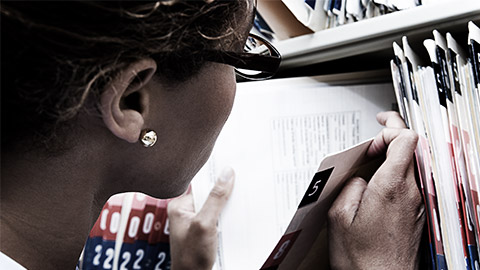Documentation and reporting requirements in aged care are necessary to ensure that accurate and comprehensive information is kept on the care and support provided to individuals.
These requirements can include:
Care plans which should be regularly reviewed and updated as needed.
- Progress notes are used to document observations, changes, and interventions made during the care and support of an individual. They provide a record of the person's care and support over time.
- Incident reports are used to document any unusual or unexpected events that occur, such as accidents, injuries, or medication errors.
- Medication administration records are used to document the administration of medication, including the type of medication, dosage, time, and any adverse reactions or side effects.
- Communication records are used to document any communication that occurs between staff and the person, their family, and other healthcare providers.
- Audits are used to regularly review and evaluate the care and support provided to ensure that it meets relevant standards and regulations.
- Statistical data is used to track and monitor the care and support provided to older adults, and to identify patterns and trends that may require further attention.

Every client has the right to their confidentiality, privacy and dignity. This includes demonstrating respect for the client’s preferences, belongings, information and their body.
Organisations have strict policies on the way in which you are expected to maintain a person’s dignity, as well as their privacy. As an employee, you will have a legal duty of care to meet the needs of clients by working in a manner that does not cause them harm.
Upholding a person’s dignity can include:
- providing appropriate and safe choices
- acknowledging a person’s right to make decisions for themselves
- not making value judgments about what is right and wrong for other people
- professionally responding and communicating to the client regardless of your opinions about their behaviour and values.
- considering the client’s perspective
- keeping in mind that the client has the right to respect and dignity; this includes respecting their choices.
- using effective communication skills such as active listening, positive body language and showing empathy.
Confidentiality and privacy can include how a person’s daily activities and support are carried out (for example undressing in private) and also their care support arrangements, records and information.
Some examples of confidentiality and privacy:
- The storage of client information and who has access.
- Who do you share aspects of the client's health status or care needs with?
- Where family members or other clients make enquiries about a client not revealing personal information.
- Not sharing information without consent.
- Keeping systems, documents and records secure.
Watch
The following video provides information on promoting the independence, dignity and well-being of the elderly and people with disability:

Employers and employees are responsible for complying with reporting requirements either through organisational policy and governance and/or legislative requirements. When starting employment, a worker is usually given an induction that will include your roles and responsibilities for reporting. It might include how to write reports, what should be included when they should be completed by and who should approve or sign them off. Reporting requirements could include:
- completing individual plans
- attending and reporting at progress meetings
- completing mandatory documentation
- reporting any risks, hazards or safety concerns
- completing forms and records associated with a client’s care and support
- recording observations
- reporting weekly to a supervisor.
The reporting documentation may be held digitally, in hard copy or both. They would need to be kept secure, private and confidential and an accurate reflection of what is being reported. Reports can be used to identify changes in the client that may need to be addressed by modifying an individualised plan. As the person responsible for delivering a service to the client, you are best positioned to monitor and report on their progress.
Mandatory reporting may be required by law or a requirement that the organisation has mandated.
These provide clear processes for employees to follow in the event of incidences occurring in the workplace. It can also provide frameworks for reporting such as alleged or suspected situations of abuse or critical incidents.
Different organisations will have compulsory reporting, for example:
- a reportable assault
- unlawful sexual contact
- unexplained absences (i.e., missing person)
- reporting a notifiable incident
- Workplace Health and Safety mandatory reporting
- financial reporting
- substance abuse
- physical injury.

Another reporting requirement of your job might be to record and document any observations or concerns about the clients you care for. These may include case notes, care plans, incident reports, family details, personal history, progress reports, financial dealings and other forms of documentation.
Try to be aware of changes in the older person’s condition, no matter how small. Seemingly insignificant symptoms and hazards can quickly become larger problems and injuries. Observation includes watching and listening for signs of problems that could be prevented or reduced.
The organisation may provide clear guidelines, policies and protocols for completing documentation. For example, you may have to use specific templates, complete a form within a certain timeframe or store it in a specific folder on the organisation’s network.
Reports can be:
- verbal (telephone or face to face)
- non-verbal (progress reports, case notes, anecdotal or running records, incident reports, observation charts, fluid balance charts, etc.).
A few things of importance:
- Handwriting must be legible
- The information must be accurate
- It should be stored securely
- Reports remain private and confidential
- Only available to those authorised
- Written in clear English
- The information must be objective.
Additionally, you may be responsible for completing different documentation on a daily, weekly or time basis. Or if anything exceptional happens, or you observe changes that impact the welfare of the client, these might need to be documented and immediately reported to the supervisor.
Under the Freedom of Information Act 1982 clients, or their legal representatives, have a right to read anything that you have written about them so be sure to use factual, respectful language at all times.
The recording and documenting of incident/accident reports, workplace health and safety logs and registers, should be completed as close to the time of the incident as possible. These might be used in a court of law, so you need to ensure that you are clear about the organisation's procedures for reporting. Always make sure your reports are signed and dated.
Furthermore, organisations rely on the accurate completion of the documentation in order to receive government and other funding.
In an emergency, you would most probably be required to report to the supervisor immediately, this would also need to be documented in a report to describe exactly what you have seen, smelled, heard, measured or felt. It can provide the information needed by a specialist such as a doctor so that they have a clear picture of what is happening with the client and how urgently they may need treatment and what type this may be.
The organisation that you work for may require both hard and soft copy documenting of client and organisational records and reporting technologies used within a care support facility may use information systems to support the completion, recording and storing of reports. It may also be linked to assistive technology, where a person’s vitals are inputted into a reporting system, government agencies, clinical software information systems or medication management software.
These technologies can support an organisation to provide the best care for a client by using the information and data collected and reported to support funding, upgrades or obtain timely medication.
Resident of the Day Reporting
ROD is a process where each resident is allocated a turn to have vital signs and other documentation completed on a specified day. ROD reporting can include:
- Measuring and recording the person’s weight
- Taking and recording the person’s vital signs, including temperature, blood pressure, pulse and respiration rate
- ROD reporting is recorded in the person’s file.
Monitoring Forms
Monitoring forms are a common way to report non-urgent problems when you work in a home setting. Monitoring forms are sent to your manager on a regular basis. Monitoring forms are the place to document issues such as non-urgent hazards, minor changes in the person’s conditions, or client requests for referrals to other services.
Incident Reports
Incident reports are important ways to record workplace health and safety issues. They should be completed if you see or hear anything that creates a hazard to workers, clients or other people, and if there has been an incident that did or could have caused harm.
There are strict legal requirements for reporting serious incidents in residential aged care, under The Serious Incident Response Scheme (SIRS).
Furthermore, organisations rely on the accurate completion of the documentation in order to receive government and other funding.
In an emergency, you would most probably be required to report to the supervisor immediately, this would also need to be documented in a report to describe exactly what you have seen, smelled, heard, measured or felt. It can provide the information needed by a specialist such as a doctor so that they have a clear picture of what is happening with the client and how urgently they may need treatment and what type this may be.
The organisation that you work for may require both hard and soft copy documenting of client and organisational records and reporting technologies used within a care support facility may use information systems to support the completion, recording and storing of reports. It may also be linked to assistive technology, where a person’s vitals are inputted into a reporting system, government agencies, clinical software information systems or medication management software.
These technologies can support an organisation to provide the best care for a client by using the information and data collected and reported to support funding, upgrades or obtain timely medication.
Resource

You can find more information about your responsibilities under the Serious Incident Reporting Scheme on the Aged Care Quality and Safety Commission’s website
The security and confidentiality of client information is a key responsibility for any organisation. The Privacy Act 1988 highlights the importance of collecting and recording information about Australian citizens in a manner that upholds the law.
Secure records
Hard copy and electronic files must be kept secure, with appropriate measures in place such as locks on cabinets, password protection, data backed up and they must only available to those with authority.
Clients have the right to feel confident that their personal information is both protected and respected and that their information is used only for the purpose identified.
Some documentation might be completed in a setting other than the workplace, such as a client's home, or your home study. It is then your responsibility to ensure that the information is kept secure.
Most organisations today will have clear policies and procedures for keeping and storing information. This may relate to clients, employees and any related organisational documents and information. It could relate to both digital and hard copy documentation.
It will also follow maintaining the privacy of client information, as required by law. Therefore, as mentioned above, all client files should be kept in a secure area with access to authorised personnel only.
Where the information is stored on a computer network or digitally, the files should be kept secure, password protected and only accessible to those with the authority to do so.
Where hard copy files are no longer required, they are usually destroyed by shredding or incineration after a specific period of time as required by law.
If you become aware of any breaches of security of information, then you should report immediately to the person in your organisation that is responsible for maintaining documentation.
Activity
The following link provided information on privacy rights.
What are four (4) strategies that you could use to ensure that a client’s individualised plan is kept safe and secure?
Important
You must follow your organisations reporting requirements and complete standard forms and documents.
- Aged Care Quality and Safety Commission. (n.d.). Better practice guide to complaints handling in aged care services. www.agedcarequality.gov.au. Retrieved August 7, 2021, from https://www.agedcarequality.gov.au/resource-library/better-practice-guide-complaints-handling-aged-care-services
- Aged Care Quality and Safety Commission. (2018). The complaints process. Agedcarequality.gov.au. https:// www.agedcarequality.gov.au/making-complaint/ complaints-process
- Aged Care Quality and Safety Commission. (2019). Quality Standards | Aged Care Quality and Safety Commission. Agedcarequality.gov.au. https://www.agedcarequality. gov.au/providers/standards
- Aged Care Quality and Safety Commission. (2021a). Serious Incident Response Scheme | Aged Care Quality and Safety Commission. Agedcarequality.gov.au. https://www.agedcarequality.gov.au/providers/serious-incident-response-scheme
- Aged Care Quality and Safety Commission. (2021). Restrictive Practices. Australian Government, https:// www.agedcarequality.gov.au/minimising-restrictive practices/resources
- Aged Care Quality and Safety Commission. (2021b). What is the SIRS: Overview. Www.youtube.com. https://www.youtube.com/watch?v=2W-NHTNVtOs
- Aged Care Quality and Safety Commission. (2021). Guidance and resources for providers to support the Aged Care Quality Standards. https://www. agedcarequality.gov.au/resources/guidance-and-resources-providers-support-aged-care-quality-standards
- Alzheimer’s Australia Vic. (2015). Purposeful activities for dementia: Alzheimer’s Australia VIC. In YouTube https://www.youtube.com/watch?v=9Y6LCpL8HUU.
- Australian Government Department of Health. (2017a). ACFI: A guide for providers of aged care. Www.youtube. com. https://youtu.be/zxeJRpU1AwQ
- Australian Government Department of Health. (2017b). LGBTI: Inclusion and Awareness in the aged care. Www. youtube.com. https://youtu.be/TvpXe_gDv1E
- Australian Government Department of Health. (2017c). My Aged Care - Overview of Home Care Packages. Www.youtube.com. https://www.youtube.com/watch?v=PQtsUgeLVWI
- Australian Government Department of Health. (2018). Aged care. Australian Government Department of Health. https://www.health.gov.au/health-topics/aged-care
- Australian Government Department of Health. (2019). The Aged Care Funding Instrument (ACFI).
- Australian Government Department of Health. https://humanrights.gov.au/ Australian Human Rights Commission. (n.d.).
- LGBT older people | Australian Human Rights Commission. Humanrights.gov.au. https://humanrights.gov.au/our-work/lgbti/lgbt-older-people
- Australian Human rights commission. (n.d.). Home | Australian Human Rights Commission. Humanrights.gov. au. https://humanrights.gov.au/
- CareChannel. (2019a). Helping Someone Shave. Www.youtube.com. https://www.youtube.com/watch?v=o0JX3DwHKbU
- CareChannel. (2019b). How To Assist Someone With A Shower. Www.youtube.com. https://youtu.be/awrSKeHYTOM CareChannel. (2019c).
- How to Help with Getting Dressed - Caregiver Tips. Www.youtube.com. https://www.youtube.com/watch?v=X9PF5FYxAE0 CareChannel. (2019d).
- Understanding the Normal Aging Process. Www.youtube.com. https://www.youtube.com/watch?v=aLY4NTfAfcg
- Continence Foundation of Australia. (n.d.). Aged care resources. Continence Foundation of Australia. https:// www.continence.org.au/professionals/aged-care-resources Continence Foundation of Australia. (2016).
- How to choose the right continence product. Www.youtube.com. https://www.youtube.com/watch?v=OKOUsuYJ2Jk
- Dementia Australia. (2014, August 11). Therapies and communication approaches. Dementia.org.au. https:// www.dementia.org.au/national/support-and-services/carers/therapies-and-communication-approaches
